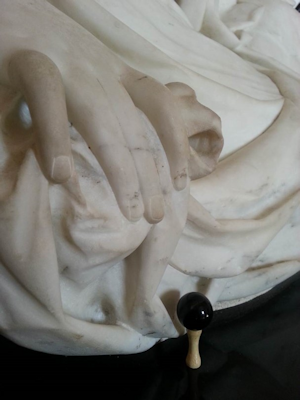
RTI in this case has been an invaluable tool that has allowed us to answer our initial research question with some definition. The team recorded RTIs at different scales (see Figure 25) and from different viewpoints (see Figure 9) in order to build a record of the tomb that might be shared with others to encourage further interpretation.

In spite of the arguments surrounding this case that occurred when the monument remained hidden, through our investigation of the object itself, the treatment of the tomb is clearer. Moreover, the pock-marking episode adds extra depth to the tomb's biography and is part of its strange journey from location to location around the church. It also may account for its transitions from distant or immediate visibility to obscurity and back to its present, rather staged, visibility again. It helps to reveal the tomb not just as a monument to a dead woman but as something that evoked many different emotional, sensory and ideological responses.
Over time it has continued to exercise its agency – a quality it even managed to retain when it became part of its own mysterious legend by being hidden away in the vault. Dame Mary may well appear to us in her Baroque stone flesh as a woman who is 'piously contemplating the uncertainty of this life' but her request for post-mortem physical veracity has led to a very lively 339 years of travel, veneration, antipathy, argument and, finally, cultural restoration. We suspect her monument's journey is by no means over as it continues to reveal new aspects of its creation, especially as the discussion surrounding Dame Mary's monument is perhaps still as lively as when it first appeared and took its place in the chancel of its living author's parish church.
Internet Archaeology is an open access journal based in the Department of Archaeology, University of York. Except where otherwise noted, content from this work may be used under the terms of the Creative Commons Attribution 3.0 (CC BY) Unported licence, which permits unrestricted use, distribution, and reproduction in any medium, provided that attribution to the author(s), the title of the work, the Internet Archaeology journal and the relevant URL/DOI are given.
Terms and Conditions | Legal Statements | Privacy Policy | Cookies Policy | Citing Internet Archaeology
Internet Archaeology content is preserved for the long term with the Archaeology Data Service. Help sustain and support open access publication by donating to our Open Access Archaeology Fund.